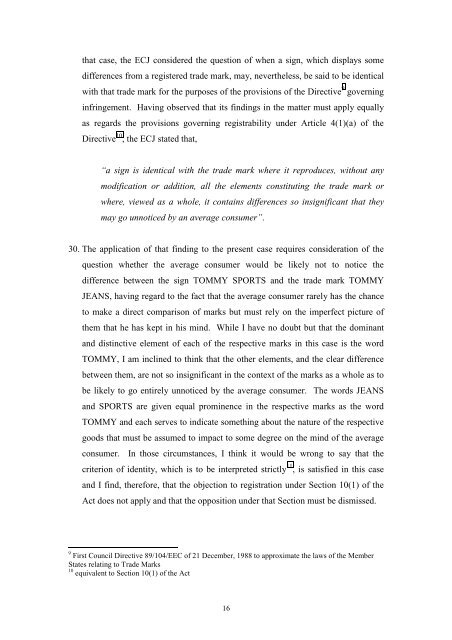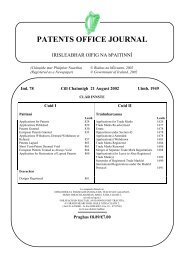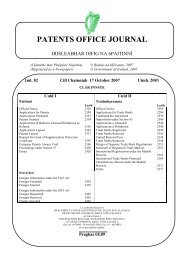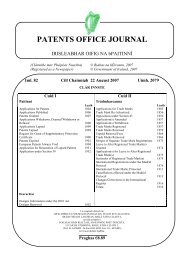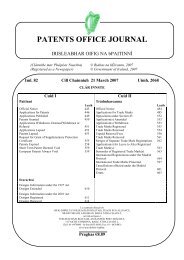TRADE MARKS ACT, 1963 - Irish Patents Office
TRADE MARKS ACT, 1963 - Irish Patents Office
TRADE MARKS ACT, 1963 - Irish Patents Office
You also want an ePaper? Increase the reach of your titles
YUMPU automatically turns print PDFs into web optimized ePapers that Google loves.
that case, the ECJ considered the question of when a sign, which displays some<br />
differences from a registered trade mark, may, nevertheless, be said to be identical<br />
with that trade mark for the purposes of the provisions of the Directive 9 governing<br />
infringement. Having observed that its findings in the matter must apply equally<br />
as regards the provisions governing registrability under Article 4(1)(a) of the<br />
Directive 10 , the ECJ stated that,<br />
“a sign is identical with the trade mark where it reproduces, without any<br />
modification or addition, all the elements constituting the trade mark or<br />
where, viewed as a whole, it contains differences so insignificant that they<br />
may go unnoticed by an average consumer”.<br />
30. The application of that finding to the present case requires consideration of the<br />
question whether the average consumer would be likely not to notice the<br />
difference between the sign TOMMY SPORTS and the trade mark TOMMY<br />
JEANS, having regard to the fact that the average consumer rarely has the chance<br />
to make a direct comparison of marks but must rely on the imperfect picture of<br />
them that he has kept in his mind. While I have no doubt but that the dominant<br />
and distinctive element of each of the respective marks in this case is the word<br />
TOMMY, I am inclined to think that the other elements, and the clear difference<br />
between them, are not so insignificant in the context of the marks as a whole as to<br />
be likely to go entirely unnoticed by the average consumer. The words JEANS<br />
and SPORTS are given equal prominence in the respective marks as the word<br />
TOMMY and each serves to indicate something about the nature of the respective<br />
goods that must be assumed to impact to some degree on the mind of the average<br />
consumer. In those circumstances, I think it would be wrong to say that the<br />
criterion of identity, which is to be interpreted strictly 11 , is satisfied in this case<br />
and I find, therefore, that the objection to registration under Section 10(1) of the<br />
Act does not apply and that the opposition under that Section must be dismissed.<br />
9<br />
First Council Directive 89/104/EEC of 21 December, 1988 to approximate the laws of the Member<br />
States relating to Trade Marks<br />
10<br />
equivalent to Section 10(1) of the Act<br />
16


